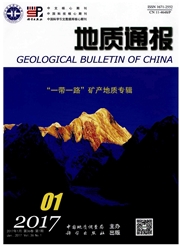

 中文摘要:
中文摘要:
在青藏高原腹地,晚新生代以来除发育南北向的伸展构造以外,还发现有一系列时代较新的近东西向正断层控制的伸展构造.空间上呈现出平行排列的宽缓凹槽及其间相对狭窄的山梁相互间隔的活动地貌结构特点。称这种地貌结构为“槽梁地貌”。数字高程模型(DEM)的研究表明,研究区近东西向的伸展构造在地貌上切割了近南北向的双湖盆地。结合断层运动学、年代学及盆地沉积作用的研究,认为近东西向的伸展构造的发育最早可能始于中新世,与近南北向的伸展构造交织发育,断裂的活动性在第四纪随着高原腹地海拔抬升得到了显著的增强。青藏高原隆升后重力作用导致了不同方向断陷盆地的发育。
 英文摘要:
英文摘要:
In central Tibetan Plateau, besides the NS-tranding extension structure after late Cenozoic, a series of nearly EW-striking extension structures, controlled by EW-trending normal faults, were found during the field work. Geomorphology was characterized by the parallel-relief valleys separated by the relatively narrow ridges and the rift-ridge landform. The DEM analysis shows that the EW-tranding extension structure cutting the NS-trending Shuanghu basin in the study area. Studies of the fault kinematics, chronolo- gy and sedimentation in the fanlt-controUed basin suggest that the activity of the EW-trending normal faults began in the Miocene and these faults were probably developed alternately with the NS-trending extension structure. Furthermore, with the increasing of the elevation of central Tibetan Plateau, the activity of the EW-trending faults were obviously strengthened in Quaternary. The gravity action on the high-standing plateau resulted in the development of grabens in different directions.
 同期刊论文项目
同期刊论文项目
 同项目期刊论文
同项目期刊论文
 Pre-Rodinia supercontinent Nuna shaping up: A global synthesis with new paleomagnetic results from N
Pre-Rodinia supercontinent Nuna shaping up: A global synthesis with new paleomagnetic results from N Extended stratigraphy, palynology and depositional environments record the initiation of the Himalay
Extended stratigraphy, palynology and depositional environments record the initiation of the Himalay Systematics and palaeoecology of Changhsingian (Late Permian) Ambocoeliidae brachiopods from South C
Systematics and palaeoecology of Changhsingian (Late Permian) Ambocoeliidae brachiopods from South C Climatic and tectonic uplift evolution since similar to 7 Ma in Gyirong basin, southwestern Tibet pl
Climatic and tectonic uplift evolution since similar to 7 Ma in Gyirong basin, southwestern Tibet pl Organic carbon isotope constraints on the dissolved organic carbon (DOC) reservoir at the Cryogenian
Organic carbon isotope constraints on the dissolved organic carbon (DOC) reservoir at the Cryogenian How severe is the modern biotic crisis? - A comparison of global change and biotic crisis between Pe
How severe is the modern biotic crisis? - A comparison of global change and biotic crisis between Pe Environmental determinants and ecologic selectivity of benthic faunas from nearshore to bathyal zone
Environmental determinants and ecologic selectivity of benthic faunas from nearshore to bathyal zone Diagenetic control of magnetic susceptibility variation in Core MD98-2172 from the Eastern Timor Sea
Diagenetic control of magnetic susceptibility variation in Core MD98-2172 from the Eastern Timor Sea Sedimentary geochemistry and provenance of the Lower and Middle Devonian Laojunshan Formation, the N
Sedimentary geochemistry and provenance of the Lower and Middle Devonian Laojunshan Formation, the N Paleogene-Neogene stratigraphic realm and sedimentary sequence of the Qinghai-Tibet Plateau and thei
Paleogene-Neogene stratigraphic realm and sedimentary sequence of the Qinghai-Tibet Plateau and thei Zoophycos composite ichnofabrics and tiers from the Permian neritic facies in South China and south-
Zoophycos composite ichnofabrics and tiers from the Permian neritic facies in South China and south- Palaeoecology and taphonomy of two brachiopod shell beds from the Anisian (Middle Triassic) of Guizh
Palaeoecology and taphonomy of two brachiopod shell beds from the Anisian (Middle Triassic) of Guizh Isotopic evidence for an anomalously low oceanic sulfate concentration following end-Permian mass ex
Isotopic evidence for an anomalously low oceanic sulfate concentration following end-Permian mass ex Provenance record of a foreland basin: Detrital zircon U-Pb ages from Devonian strata in the North Q
Provenance record of a foreland basin: Detrital zircon U-Pb ages from Devonian strata in the North Q Revised conodont zonation and conodont evolution across the Permian-Triassic boundary at the Shangsi
Revised conodont zonation and conodont evolution across the Permian-Triassic boundary at the Shangsi Microbial lipid records of highly alkaline deposits and enhanced aridity associated with significant
Microbial lipid records of highly alkaline deposits and enhanced aridity associated with significant The origin of decoupled carbonate and organic carbon isotope signatures in the early Cambrian (ca. 5
The origin of decoupled carbonate and organic carbon isotope signatures in the early Cambrian (ca. 5 Microbial response to limited nutrients in shallow water immediately after the end-Permian mass exti
Microbial response to limited nutrients in shallow water immediately after the end-Permian mass exti Morphological association of microbially induced sedimentary structures (MISS) as a paleoenvironment
Morphological association of microbially induced sedimentary structures (MISS) as a paleoenvironment Geochemical evidence from bio-apatite for multiple oceanic anoxic events during Permian-Triassic tra
Geochemical evidence from bio-apatite for multiple oceanic anoxic events during Permian-Triassic tra 期刊信息
期刊信息
